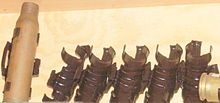avia.wikisort.org - Weapon
The AK-230 is a Soviet fully automatic naval twin 30 mm gun. Its primary function is anti-aircraft. It is mounted in an enclosed automatic turret and directed by radar. AK-230 is widely used,[1] mounted on big warships as well as small craft. About 1450 guns were produced in the USSR, and about 300 were produced in China as the Type 69. It was succeeded by the more powerful AK-630 from the mid-to-late 1970s.
This article includes a list of general references, but it lacks sufficient corresponding inline citations. (March 2020) |
| AK-230 | |
|---|---|
 AK-230 mounted on Finnish minelayer Keihässalmi | |
| Type | CIWS |
| Place of origin | Soviet Union |
| Production history | |
| Variants | See Variants |
Development and service

Development of the weapon began during the 1950s, with the first trial weapon fitted to the Osa class of fast attack missile boats and Shershen class torpedo boats. The weapon was officially accepted into service in 1969. Its service life was relatively short, due to the fielding of the AK-630 system in the mid-1970s, which uses the same mountings and can be controlled by the same fire control systems. While its 30×210 mm round was much more powerful than the AK-630's 30×165 mm one, having the muzzle velocity of 1050 m/s (the same as with 30×173 mm GAU-8's cartridge), the moderately powered AK-630's round allowed for much higher rates of fire, especially in a Gatling-type weapon, which was considered more advantageous for the anti-aircraft system.
Description
The weapon consists of two stabilized NN-30 30 mm water-cooled four chamber revolver cannons, which are mounted inside a riveted steel turret. The gun mechanism is gas operated.[1] The guns each weigh 155 kg and have barrels 1930 mm long, and a total length of 2670 mm. The barrels are rifled with 12 grooves. The guns each have a rate of fire of 1,000 round per minute;[citation needed] they are fed by independent 500-round belts of ammunition.
The rounds are electrically fired; propellent gases are used to eject the spent shells and belt links into a space between the magazine and the hull. Ballistic maximum range for the weapon is about 6.7 km, but realistic ranges for engaging air targets are quoted as between 2.5 and 4 km.
The weapon is remote-directed, typically by a fire-control system linked to either a Drum Tilt or Muff Cobb radar systems.
Ammunition
The AK-230 fires specially developed 30x210B 30 mm ammunition that is electrically primed. Two rounds were developed: a high-explosive round with an impact fuze, and an armour-piercing round. The Chinese Type 69 fires only a locally produced version of the high-explosive round. Ammunition is also produced in Romania and Serbia.


| Type | HE | AP-T |
|---|---|---|
| Designation | OF-83D | BR-83 |
| Weight | ||
| Round | 1.13 kg | 1.12 kg |
| Projectile | 0.27 kg | 0.35 kg |
| Explosive content | 30 g of A-IX-2 | - |
| Muzzle velocity | 1,050 m/s | |
Specifications
- Calibre: 30 mm
- Traverse: +180 to -180 degrees at 35 degree/s[citation needed]
- Elevation: -12 to +87 degrees at 50 degree/s[citation needed]
- Mounting weight: 1857 kg to 1905 kg
- Rate of fire: 2,000 rpm (system)[citation needed]
- Gun Weight: 343.9 lbs. (156 kg)
- Gun Length oa: 84.25 in (2.140 m)
- Bore Length: 74.69 in (1.897 m)
- Rifling Length: 71.06 in (1.805 m)
- Grooves: 12
- Chamber Volume: 13.49 in3 (0.221 dm3)
- Rate Of Fire: over 1,000 rounds per minute cyclic
Variants
- AK-230 A type - For ships with 220 V DC power systems.
- AK-230 B type - For ships with 380 V AC power systems.
- AK-230M - Less magnetized version for minesweepers (380 V AC).
- Type 69 - Chinese upgraded version, total weight 3,600 kg. Shells are ejected outside of the turret. a faster 50 degree/second traverse.
References
- Norman Friedman (2006). The Naval Institute Guide to World Naval Weapon Systems. Naval Institute Press. p. 468. ISBN 978-1-55750-262-9.
General references
| Wikimedia Commons has media related to AK-230. |
- Jane's Naval Weapon Systems Issue Thirty Three
- Navy Weapons.com
- Koll, Christian (2009). Soviet Cannon - A Comprehensive Study of Soviet Arms and Ammunition in Calibres 12.7mm to 57mm. Austria: Koll. p. 323. ISBN 978-3-200-01445-9.
На других языках
[de] AK-230
Die AK-230 ist eine schiffsgestützte sowjetische Flugabwehrkanone im Kaliber 30 × 210 mm B.- [en] AK-230
[it] 30 mm AK-230
L'AK-230 è una mitragliera a doppia canna sovietica da 30mm, il cui utilizzo principale è di tipo antiaereo a corto raggio. È montata all'interno di una torretta chiusa e controllata automaticamente da un radar noto come 'Drum Tilt'. L'AK-230 è probabilmente l'arma più prodotta al mondo della sua classe, difatti è stata montata sia nelle navi di piccole dimensioni, sia in quelle più grandi. Circa 1.450 furono prodotti nella vecchia Unione Sovietica, 300 in Cina come Tipo 69. L'AK-230 fu sostituito dal più potente ADG-630 a partire dalla metà degli anni 70, che faceva un salto ulteriore di capacità, con una precisione di tiro sufficiente per il compito antimissile.[ru] АК-230
АК-230 — советская корабельная 30 мм автоматическая спаренная артиллерийская установка с двумя орудиями НН-30.Другой контент может иметь иную лицензию. Перед использованием материалов сайта WikiSort.org внимательно изучите правила лицензирования конкретных элементов наполнения сайта.
WikiSort.org - проект по пересортировке и дополнению контента Википедии